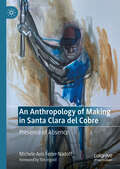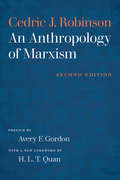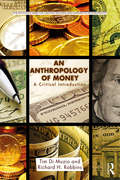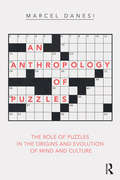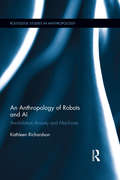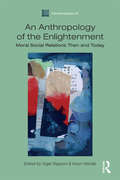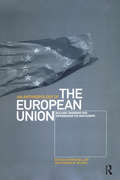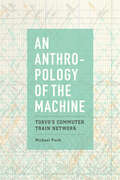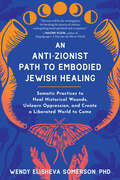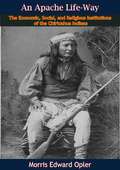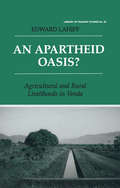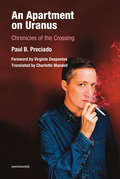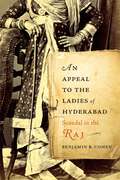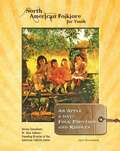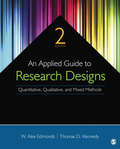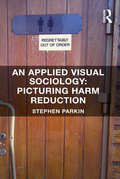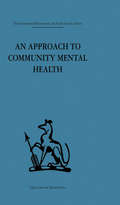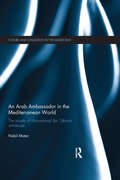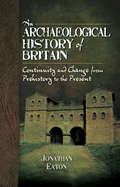- Table View
- List View
An Anthropology of Making in Santa Clara del Cobre: Presence of Absence
by Michele Avis Feder-NadoffThis book offers a nuanced reflection on the meaning of making and artisan agency, demonstrating how copper-smithing produces not only objects, but also lives, worlds, meanings, and social transformation. Through long-term ethnography, grounded in apprenticeship to master coppersmith Jesús Pérez Ornelas, Feder-Nadoff’s intimate description of communal and artisanal life in Santa Clara del Cobre, Michoacán, México provides a critical reappraisal of aesthetics and compelling ways to think about how aura and agency are produced. By mapping flows and frictions between persons, places, and things, this study closes the gap between economic and socio-political analysis of craft, on the one hand, and aesthetic, material, and phenomenological studies of making, on the other. Although craft historically plays a prominent national, even ideological role in Mexico, as in many countries, most artisans ironically remain absent, often living in marginalized, precarious circumstances. By tracing the cycles of life, death, and afterlife, of these maker-protagonists, their bodies of knowledge, skilled performances, and objects, this poetic monograph testifies to their presence.
An Anthropology of Marxism (Race And Representation Ser.)
by Cedric J. RobinsonAn Anthropology of Marxism offers Cedric Robinson's analysis of the history of communalism that has been claimed by Marx and Marxists. Suggesting that the socialist ideal was embedded both in Western and non-Western civilizations and cultures long before the opening of the modern era and did not begin with or depend on the existence of capitalism, Robinson interrogates the social, cultural, institutional, and historical materials that were the seedbeds for communal modes of living and reimagining society. Ultimately, it pushes back against Marx's vision of a better society as rooted in a Eurocentric society, and cut off from its own precursors. Accompanied by a new foreword by H.L.T. Quan and a preface by Avery Gordon, this invaluable text reimagines the communal ideal from a broader perspective that transcends modernity, industrialization, and capitalism.
An Anthropology of Money: A Critical Introduction (Routledge Series for Creative Teaching and Learning in Anthropology)
by Richard H. Robbins Tim Di MuzioAn Anthropology of Money: A Critical Introduction shows how our present monetary system was imposed by elites and how they benefit from it. The book poses the question: how, by looking at different forms of money, can we appreciate that they have different effects? The authors demonstrate how modern money requires perpetual growth, an increase in inequality, environmental devastation, increasing commoditization, and, consequently, the perpetual consumption of ever more stuff. These are not intrinsic features of money, but, rather, of debt-money. This text shows that, through studying money in other cultures, we can have money that better serves the broader goals of society.
An Anthropology of Puzzles: The Role of Puzzles in the Origins and Evolution of Mind and Culture
by Marcel DanesiAn Anthropology of Puzzles argues that the human brain is a "puzzling organ" which allows humans to literally solve their own problems of existence through puzzle format. Noting the presence of puzzles everywhere in everyday life, Marcel Danesi looks at puzzles in society since the dawn of history, showing how their presence has guided large sections of human history, from discoveries in mathematics to disquisitions in philosophy. Danesi examines the cognitive processes that are involved in puzzle making and solving, and connects them to the actual physical manifestations of classic puzzles. Building on a concept of puzzles as based on Jungian archetypes, such as the river crossing image, the path metaphor, and the journey, Danesi suggests this could be one way to understand the public fascination with puzzles. As well as drawing on underlying mental archetypes, the act of solving puzzles also provides an outlet to move beyond biological evolution, and Danesi shows that puzzles could be the product of the same basic neural mechanism that produces language and culture. Finally, Danesi explores how understanding puzzles can be a new way of understanding our human culture.
An Anthropology of Robots and AI: Annihilation Anxiety and Machines (Routledge Studies in Anthropology #20)
by Kathleen RichardsonThis book explores the making of robots in labs at the Massachusetts Institute of Technology (MIT). It examines the cultural ideas that go into the making of robots, and the role of fiction in co-constructing the technological practices of the robotic scientists. The book engages with debates in anthropological theorizing regarding the way that robots are reimagined as intelligent, autonomous and social and weaved into lived social realities. Richardson charts the move away from the “worker” robot of the 1920s to the “social” one of the 2000s, as robots are reimagined as companions, friends and therapeutic agents.
An Anthropology of Robots and AI: Annihilation Anxiety and Machines (Routledge Studies in Anthropology)
by Kathleen RichardsonThis book explores the making of robots in labs at the Massachusetts Institute of Technology (MIT). It examines the cultural ideas that go into the making of robots, and the role of fiction in co-constructing the technological practices of the robotic scientists. The book engages with debates in anthropological theorizing regarding the way that robots are reimagined as intelligent, autonomous and social and weaved into lived social realities. Richardson charts the move away from the “worker” robot of the 1920s to the “social” one of the 2000s, as robots are reimagined as companions, friends and therapeutic agents.
An Anthropology of the Enlightenment: Moral Social Relations Then and Today (Association Of Social Anthropologists Monographs)
by Nigel Rapport Huon WardleIn a time of intellectual uncertainty, the question of how we know what we do about human lives becomes ever more pressing. The essays collated in this volume argue that anthropology can be used to acknowledge, explore and interpret divergence and ideological conflict over human meaning. Using questions raised as part of the Enlightenment movement, this volume is structured around some of the key themes the Enlightenment fostered, including human nature, time, Earth and the Cosmos, beauty, order, harmony and design, moral sentiments, and the query of whether wealthy nations make for healthy publics. The volume focuses in particular on how 'moral sentiment' offered a guiding idea in Enlightenment thought. The idea of 'moral sentiment' is central to the essays' grappling with the ethical anxieties of contemporary anthropology. The essays therefore trace historical connections and fissures and focus on Adam Smith's attempts toward an understanding of what would later be called 'modernity'. With an afterword from Marilyn Strathern, this volume will be a strong addition to the Association of Social Anthropologists conference proceedings.
An Anthropology of the European Union: Building, Imagining and Experiencing the New Europe
by Irène BellierOne of the problems facing Europe is that the building of institutional Europe and top-down efforts to get Europeans to imagine their common identity do not necessarily result in political and cultural unity. Anthropologists have been slow to consider the difficulties presented by the expansion of the EU model and its implications for Europe in the 21st Century. Representing a new trend in European anthropology, this book examines how people adjust to their different experiences of the new Europe. The role of culture, religion, and ideology, as well as insiders' social and professional practices, are all shown to shed light on the cultural logic sustaining the institutions and policies of the European Union. On the one hand, the activities of the European institutions in Brussels illustrate how people of many different nationalities, languages and cultures can live and work together. On the other hand, the interests of many people at the local, regional and national levels are not the same as the Eurocrats'. Contributors explore the issues of unity and diversity in ‘Europe-building' through various European institutions, images, and programmes, and their effects on a variety of definitions of identity in such locales as France, Denmark, the United Kingdom, Ireland and Belgium.
An Anthropology of the Irish in Belgium: Belonging, Identity and Community in Europe
by Sean O’ DubhghaillThe first anthropological account of the Irish diaspora in Europe in the 21st century, this book provides a culture-centric examination of the Irish diaspora. Focusing less on an abstract or technical definition of Irish self-identification, the author allows members of this group to speak through vignettes and interview excerpts, providing an anthropological lens that allows the reader to enter a frame of self-reference. This book therefore provides architecture to understand how diasporic communities might understand their own identities in a new way and how they might reconsider the role played by mobility in changing expressions of identity. Providing firsthand, experiential and narrative insight into the Irish diaspora in Europe, this volume promises to contribute an anthropological perspective to historical accounts of the Irish overseas, theoretical works in Irish studies, and sociological examinations of Irish identity and diaspora.
An Anthropology of the Machine: Tokyo's Commuter Train Network
by Michael Fisch“An astute account of [Tokyo’s] commuter train network . . . and an intellectually stimulating invitation to rethink the interaction between humans and machines.” —Japan ForumWith its infamously packed cars and disciplined commuters, Tokyo’s commuter train network is one of the most complex technical infrastructures on Earth. In An Anthropology of the Machine, Michael Fisch provides a nuanced perspective on how Tokyo’s commuter train network embodies the lived realities of technology in our modern world. Drawing on his fine-grained knowledge of transportation, work, and everyday life in Tokyo, Fisch shows how fitting into a system that operates on the extreme edge of sustainability can take a physical and emotional toll on a community while also creating a collective way of life—one with unique limitations and possibilities.An Anthropology of the Machine is a creative ethnographic study of the culture, history, and experience of commuting in Tokyo. At the same time, it is a theoretically ambitious attempt to think through our very relationship with technology and our possible ecological futures. Fisch provides an unblinking glimpse into what it might be like to inhabit a future in which more and more of our infrastructure—and the planet itself—will have to operate beyond capacity to accommodate our ever-growing population.“Not a ‘rage against the machine’ but an urge to find new ways of coexisting with technology.” —Contemporary Japan“An extraordinary study.” —Ethnos“A fascinating in-depth account of the innovations, inventions, sacrifices, and creativity required to ensure Tokyo’s millions of commuters keep rolling. It also provides much food for thought as our transportation systems become increasingly reliant on automated technology.” —Pacific Affairs
An Anti-Zionist Path to Embodied Jewish Healing: Somatic Practices to Heal Historical Wounds, Unlearn Oppression, and Create a Liberated World to Come
by Wendy Elisheva Somerson PhDUnapologetically anti-Zionist and firmly rooted in Jewish spiritual values—a liberatory model for Jewish healing Body-based tools and faith-based practices for processing trauma, reclaiming our agency, and building a world where "never again" means "never again for anyone""...an accessible pathway for healing from historical trauma, releasing it from our bodies, and preventing it from being passed on to future generations. This may well be the missing piece for breaking the pattern of violence undergirding Israeli apartheid and occupation.&”—Naomi Klein, author of Doppelganger: A Trip Into the Mirror World Dr. Wendy Elisheva Somerson, PhD, shows how Jewish history lives in Jewish bodies—and how antisemitism and oppression disrupt our access to safety, dignity, and belonging. This unmetabolized trauma can lock us into a survival state that brings historical grief into the present moment…and keep us from exploring critical questions that help us tend our legacies and live into a better world.How does ancestral grief live on in our bodies and keep us from feeling safe—and how is that fear enacted on other peoples? How do we reconcile a history of persecution with the state power of Israel today?Each chapter invites us back into the body, exploring healing as a spiritual and political reclamation. With skills-based wisdom for trauma, safety, spiritually grounded intentions, and resourcing ourselves for difficult conversations, this book also helps readers understand: Trauma and healing through our bodiesJewish longing, belonging, legacies of assimilationHealing shame—of not being Jewish enough, of being too much, and of being complicitEmbodied experiences of Jewish resilience, ritual, and griefRooted in justice, care, and spiritual depth, this book asks us to live into a Judaism beyond Zionism. It invites us to heal toward liberation—to reclaim Jewish faith and release Jewish identity from the colonial project of Israel in power, skill, and community.
An Apache Campaign in the Sierra Madre: an Account of the Expedition in Pursuit of the Chiricahua Apaches in Arizona, 1883
by John G Bourke“With Crook in pursuit of Geronimo and his band.The author of this book was a U.S. soldier in addition to being a well known and highly regarded author on the Apache Wars of the later nineteenth century-in which he was an active participant. He maintained an interest, respect for and in some measure an affection for the Apaches and he also made a serious study of and wrote notable works on their customs and culture. He is perhaps best known for his classic account of the Apache Wars, 'On the Border with Crook.' This small account was written prior to his larger and more expansive work. It originally appeared as a series of articles in the Boston published 'Outing Magazine.' Bourke decided to bring his earlier writings back into print in book form, at a time when the Apaches had once again taken the war trail, to provide the American public with context to then current events. This fascinating account, which centres on the events of the Spring of 1883, concerns Crook's pursuit of the Chiricahua Apaches who broke out of San Carlos reservation to raid through Arizona and Mexico before vanishing into the fastness of the Sierra Madre. Those with any interest or knowledge in this subject will find themselves familiarly introduced to the corps of Apache Scouts, Al Sieber (Zieber), the scout and interpreter, Crook, Gatewood, Chato and of course the renowned Geronimo, as well as other names long associated with this remarkable time in the history of the Apaches and Arizona.”-Print ed.
An Apache Life-Way: The Economic, Social, and Religious Institutions of the Chiricahua Indians
by Morris Edward OplerA majority of ethnographer Morris Edward Opler’s research was done on Native American groups of the American Southwest. He studied specifically the Chiricahua Indians, who were the subjects of one of his most famous books, An Apache Life-Way: The Economic, Social, and Religious Institutions of the Chiricahua Indians. Opler studied many Native American groups, but the Apache were a main focus of his.An Apache Life-Way traces the life of an Apache year by year. Rather than a history, the book explains the day-to-day Apache experience, detailing the chronological order of one’s life. The lifestyle described in the book is from a time before the Americans started the long era of hostile interactions with the Apache.The people designated as “Apache” in this book are those who spoke the Apache language in the area that is now New Mexico, Arizona, Sonora, and Chihuahua. There were many smaller sub-groups that populated these areas, three of them different groups of the Chiricahua Apache.An Apache Life-Way is divided into several main parts: Childhood; Maturation; Social Relations of Adults; Folk Beliefs, Medical Practice, and Shamanism; Maintenance of the Household; Marital and Sexual Life; The Round of Life; Political Organization and Status; and Death, Mourning, and the Underworld. Each section is divided into more specific subcategories that explore each phase of life and the rituals associated with it.Originally published in 1941, An Apache Life-Way remains one of the most important and innovative studies of south-western Native Americans.“First-class...in the best ethnographic tradition. It fills a great gap in our anthropological knowledge and...deserves to be one of the most used of American tribal records.”—Ruth Benedict, author of Patterns of Culture
An Apartheid Oasis?: Agriculture and Rural Livelihoods in Venda
by Edward LahiffThis is a socio-economic study of agriculture and its contribution to livelihoods in Venda, one of the black "homelands" created in South Africa under apartheid. It is based on a survey of households in the Tshiombo irrigation scheme, a project in central Venda with around 600 plot-holders.
An Apartment on Uranus: Chronicles of the Crossing (Semiotext(e) / Foreign Agents)
by Paul B. PreciadoA “dissident of the gender-sex binary system” reflects on gender transitioning and political and cultural transitions in technoscientific capitalism.Uranus, the frozen giant, is the coldest planet in the solar system as well as a deity in Greek mythology. It is also the inspiration for uranism, a concept coined by the writer Karl Heinrich Ulrich in 1864 to define the “third sex” and the rights of those who “love differently.” Following Ulrich, Paul B. Preciado dreams of an apartment on Uranus where he might live beyond existing power, gender and racial strictures invented by modernity. “My trans condition is a new form of uranism,” he writes. “I am not a man. I am not a woman. I am not heterosexual. I am not homosexual. I am not bisexual. I am a dissident of the gender-sex binary system. I am the multiplicity of the cosmos trapped in a binary political and epistemological system, shouting in front of you. I am a uranist confined inside the limits of technoscientific capitalism.”This book recounts Preciado's transformation from Beatriz into Paul B., but it is not only an account of gender transitioning. Preciado also considers political, cultural, and sexual transition, reflecting on issues that range from the rise of neo-fascism in Europe to the technological appropriation of the uterus, from the harassment of trans children to the role museums might play in the cultural revolution to come. An Apartment on Uranus is a bold, transgressive, and necessary book.
An Ape’s View of Human Evolution
by Peter AndrewsOur closest living relatives are the chimpanzee and bonobo. We share many characteristics with them, but our lineages diverged millions of years ago. Who in fact was our last common ancestor? Bringing together ecology, evolution, genetics, anatomy and geology, this book provides a new perspective on human evolution. What can fossil apes tell us about the origins of human evolution? Did the last common ancestor of apes and humans live in trees or on the ground? What did it eat, and how did it survive in a world full of large predators? Did it look anything like living apes? Andrews addresses these questions and more to reconstruct the common ancestor and its habitat. Synthesising thirty-five years of work on both ancient environments and fossil and modern ape anatomy, this book provides unique new insights into the evolutionary processes that led to the origins of the human lineage.
An Appeal to the Ladies of Hyderabad: Scandal in the Raj
by Benjamin B. CohenBenjamin Cohen tells the dramatic story of Mehdi Hasan and Ellen Donnelly, whose marriage convulsed high society in nineteenth-century India and whose notorious trial reverberated throughout the British Empire, setting the benchmark for Victorian scandals. In the struggle of one couple, he exposes the fault lines that would soon tear a world apart.
An Apple a Day: Folk Proverbs and Riddles (North American Folklore for Youth)
by Gus SnedekerHave you heard these common proverbs? Let sleeping dogs lie. Where there's smoke there's fire. You can lead a horse to water, but you can't make him drink. Or what about these riddles? What is black and white and red (read) all over? Why did the chicken cross the road? Why is 6 afraid of 7? Proverbs and riddles are tiny, bite-size pieces of folklore. They make us think. They tease our brains. They may make us laugh. But most of all, they tell us something about who we are and how we see the world.
An Applied Guide to Research Designs: Quantitative, Qualitative, and Mixed Methods
by W. Alex Edmonds Thomas D. KennedyThe Second Edition of An Applied Guide to Research Designs offers researchers in the social and behavioral sciences guidance for selecting the most appropriate research design to apply in their study. Using consistent terminology, the authors visually present a range of research designs used in quantitative, qualitative, and mixed methods to help readers conceptualize, construct, test, and problem solve in their investigation. The Second Edition features revamped and expanded coverage of research designs, new real-world examples and references, a new chapter on action research, and updated ancillaries.
An Applied Guide to Research Designs: Quantitative, Qualitative, and Mixed Methods
by W. Alex Edmonds Thomas D. KennedyThe Second Edition of An Applied Guide to Research Designs offers researchers in the social and behavioral sciences guidance for selecting the most appropriate research design to apply in their study. Using consistent terminology, the authors visually present a range of research designs used in quantitative, qualitative, and mixed methods to help readers conceptualize, construct, test, and problem solve in their investigation. The Second Edition features revamped and expanded coverage of research designs, new real-world examples and references, a new chapter on action research, and updated ancillaries.
An Applied Visual Sociology: Picturing Harm Reduction
by Stephen ParkinExploring the value of photography and video as legitimate forms of social enquiry, An Applied Visual Sociology: Picturing Harm Reduction constitutes a guidebook for conducting applied visual sociology within health related or social science research projects, providing a full account of the visual research journey and presenting a tested template for conducting theoretically-driven, sociologically-informed research. Against the background of the growing popularity of visual methods, this book goes beyond using photographs for illustrative and descriptive purposes, to emphasise the importance of sociological, epistemological and analytical theory, together with methods of data collection and the presentation of images for applied purposes. As such, An Applied Visual Sociology: Picturing Harm Reduction offers a template for considering visual data as applied research, providing a full account of the manner in which visual methods can inform research and specific interventions, together with opportunities for students and practitioners to consider applied visual sociology in a series of practical or self-study tasks . It will therefore appeal not only to students and researchers involved in social and health-related qualitative research, or those seeking to conduct innovative visual projects within the social sciences, but also to scholars interested in research methods, visual ethnography and harm reduction approaches to drug use.
An Approach to Community Mental Health
by Gerald CaplanTavistock Press was established as a co-operative venture between the Tavistock Institute and Routledge & Kegan Paul (RKP) in the 1950s to produce a series of major contributions across the social sciences. This volume is part of a 2001 reissue of a selection of those important works which have since gone out of print, or are difficult to locate. Published by Routledge, 112 volumes in total are being brought together under the name The International Behavioural and Social Sciences Library: Classics from the Tavistock Press. Reproduced here in facsimile, this volume was originally published in 1961 and is available individually. The collection is also available in a number of themed mini-sets of between 5 and 13 volumes, or as a complete collection.
An Arab Ambassador in the Mediterranean World: The Travels of Muhammad ibn ‘Uthmān al-Miknāsī, 1779-1788 (Culture and Civilization in the Middle East)
by Nabil MatarThis book provides translated selections from the writings of Muhammad Ibn Othman al-Miknasi (d. 1799). The only writings by an Arab-Muslim in the pre-modern period that present a comparative perspective, his travelogues provide unique insight with in to Christendom and Islam. Translating excerpts from his three travelogues, this book tells the story of al-Miknasi’s travels from 1779-1788. As an ambassador, al-Miknasi was privy to court life, government offices and religious buildings, and he provides detailed accounts of cities, people, customs, ransom negotiations, historical events and political institutions. Including descriptions of Europeans, Arabs, Turks, Christians (both European and Eastern), Muslims, Jews, and (American) Indians in the last quarter of the eighteenth century, An Arab Ambassador in the Mediterranean World explores how the most travelled Muslim writer of the pre-modern period saw the world: from Spain to Arabia and from Morocco to Turkey, with second-hand information about the New World. Supplemented with extensive notes detailing the historic and political relevance of the translations, this book is of interest to researchers and scholars of Mediterranean History, Ottoman Studies and Muslim-Christian relations.
An Archaeological History of Britain: Continuity and Change from Prehistory to the Present
by Jonathan EatonThis authoritative and accessible volume presents an archeological of Britain across millennia, from early prehistory to the present. The Archaeological History of Britain takes us from the earliest prehistoric archaeology right up to the contemporary archaeology of the present day through the use of key sites. Historian Jonathan Eaton uses key sites to illustrate each significant time period along with a narrative of change to accompany the changing archaeological record. The wide range of evidence utilized by archaeologists, such as artefacts, landscape studies, historical sources and genetics are emphasized throughout this chronological journey. The latest theoretical advances and practical discoveries are also explored, making this the most advanced narrative of British archaeology available.
An Archaeological History of Hermitages and Eremitic Communities in Medieval Britain and Beyond (Routledge Studies in Archaeology)
by Simon RoffeyMany hermitages and eremitic communities are recorded throughout the medieval period, yet to date, there has been no comprehensive archaeological study. This richly illustrated book will consequently discuss a range of hermitages and introduce the reader to their architectural forms, spaces, location and environments as well as the religious practices associated with them. It will focus primarily on the British material but will nonetheless consider this within a wider comparative framework. Overall, it will offer an archaeological history of hermitages and presents a unique window into a lost world of medieval spirituality and religious life. Key related themes will include the earliest archaeological evidence for hermits (eremitic life) in India, China and East Asia, pre- and early Christian desert hermitages, cave hermitages, eremitic communities, saints and missionary hermits, life and diet, medieval mysticism and the contemplative tradition, secular and ornamental hermitages and hermits in post-medieval and contemporary society. This book offers an illustrated archaeological history of hermitages and eremitic communities, with reference to key examples and case studies. It will therefore appeal to both academics, students and a more general readership interested in archaeology, history, comparative religion, architecture, religion and belief, spirituality, medieval Britain, modern contemplative practice and contemporary heritage issues.
